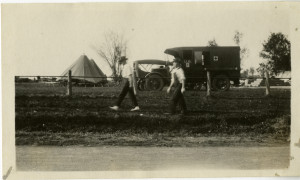
Two men walk past a Red Cross truck after a tornado in Castle Rock, Minnesota on May 20, 1920. The truck may or may not have been associated with the Northfield Red Cross chapter.
Did you know May 30 – July 4 is the first-ever Northfield History Month? Learn more about the events here.
Every weekday this Northfield History Month, come on over to the Northfield History Collaborative to learn a little more about one of the newest additions to our online collection of materials that help tell Northfield’s history.
The Northfield Red Cross minutes of 1917 to 1942 include parts of two world wars, a flu epidemic, and the Great Depression. There’s some good stuff in here!
1917 was when the Northfield chapter organized, though groups already existed at both of the colleges. They gained members very quickly, with 1,200 by the fall of that year.
The early minutes are less explicit about just what they did other than raising money for local, national and international work:
The ladies were urged to come to headquarters to sew and were given an opportunity to express a preference as to which afternoon each member could most conveniently give to this work each week.
Just after the war, in early 1919, they do share some figures that shed a little light on their action:
Mrs. Hill, as chairman of woman’s work, gave the report showing that a total of 11,509 finished articles had been made and shipped by the Northfield Chapter. An additional 2,019 had been sent from Oct. 1st to Jan 1st of this year. 916 linen articles had been sent to French hospitals in answer to a special call from Headquarters. … From Oct. 1917 to Dec. 1918, 67,477 dressings had been made in Northfield, at headquarters and by the College auxiliaries of St. Olaf and Carleton.
The Spanish influenza epidemic hit toward the end of World War I. The November 1918 minutes show that the local Red Cross was making plans in case of emergency:
The object of the meeting was the discussion of measures to be taken in case of a threatened epidemic of Influenza. Mr. Roe moved that Mr. Spohn, Miss Hill and Mr. Fobes be empowered to appoint all committees necessary to meet the situation. Motion carried. The following committees were appointed. Emergency Hospital: Roy Moses, Chr., F. B. Hill, C. F. Draper, A. O. Netland, Dr. J. G. Phillips. Supplies: Dr. Cruttenden, Chr., Prof. Dungay, P. O. Holland, Mrs. Flaten, Mrs. Hamblin, Mrs. [Malon?].
The flu epidemic also was responsible for the Red Cross postponing its October 1918 annual meeting for three months!
Once the war was over, the local chapter did remain active. It helped to employ a school nurse and a rural nurse; offered educational health and hygiene courses; and helped with natural disasters, such as a tornado in Randolph. It also provided local relief during the Great Depression, including distribution of clothing (and government cloth), flour, seeds, shoes, and glasses for schoolchildren.
Then came the second world war. Northfield residents helped out by sewing and knitting items to be sent overseas, among other projects. Sewing and knitting projects met item quotas sent from national headquarters. Because this minutes book does not span all of World War II, we simply get an idea of how they started out their efforts, even before Pearl Harbor:
Miss Stewart gave a report on the sewing and knitting units stating that a total of 376 garments, including 14 layettes had been made during the period beginning April 1, 1940 and ending March 1, 1941.
Later notes add that individuals from every church in Northfield had been involved in sewing and knitting for war relief by late 1941.
By early 1942, the Northfield Red Cross was busy enough that it needed a space to coordinate its activities.
Mrs. Wolf and Miss Piesinger made a report of their findings on rooms for use of the chapter. Motion: Odegaard, Spohn, That we accept the generous offer of M. Tschann and Company for the use of the two vacant office rooms in the Central Block, the rent of such office rooms to be $2.00 per month, heat and light included.
The room is open for sewing on Tuesdays and Thursdays from 9 a.m. to 5 p.m. The room is open on Saturdays from 2 p.m. to 5 p.m. to distribute and receive the work which is taken outside the workroom.
Of course, the local chapter also gathered and raised funds toward national and international needs. In early 1940, the National Red Cross had set Northfield’s financial quota (over what timeframe is unclear) at $320, then quickly doubled it in light of rising needs. Northfield set its own goal for the timeframe at $1,000, having already raised $950.
Northfield seems to have been putting forth great effort toward war relief, even early on!
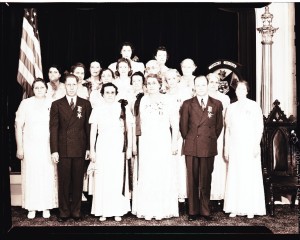



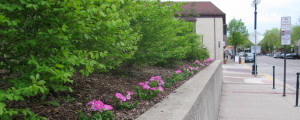 Did you know May 30 – July 4 is the first-ever Northfield History Month? Learn more about the events
Did you know May 30 – July 4 is the first-ever Northfield History Month? Learn more about the events  Did you know May 30 – July 4 is the first-ever Northfield History Month? Learn more about the events
Did you know May 30 – July 4 is the first-ever Northfield History Month? Learn more about the events 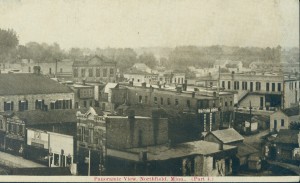 Did you know May 30 – July 4 is the first-ever Northfield History Month? Learn more about the events
Did you know May 30 – July 4 is the first-ever Northfield History Month? Learn more about the events 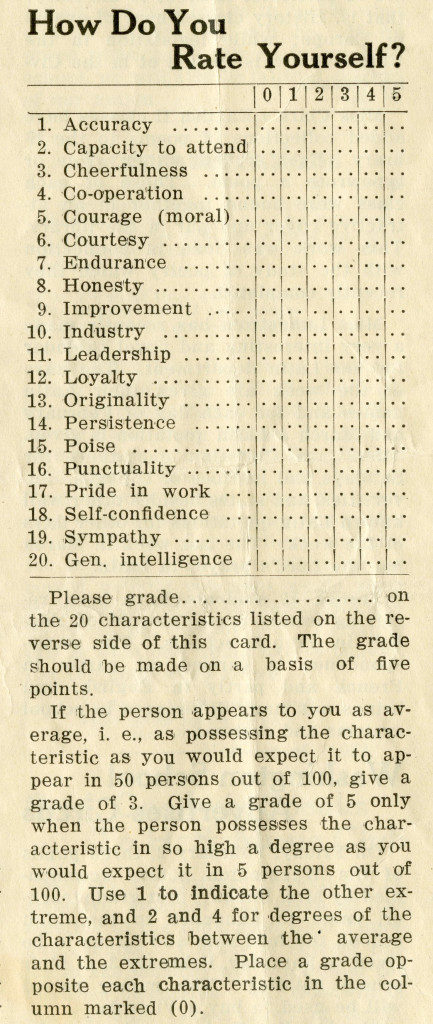
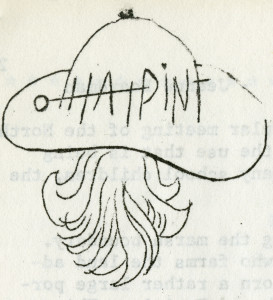 Did you know May 30 – July 4 is the first-ever Northfield History Month? Learn more about the events
Did you know May 30 – July 4 is the first-ever Northfield History Month? Learn more about the events 